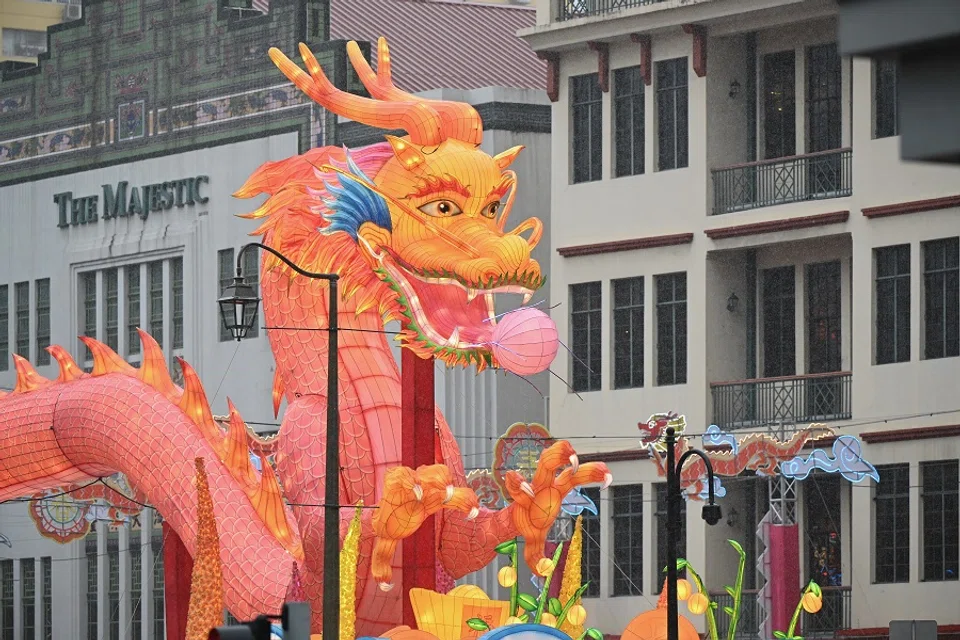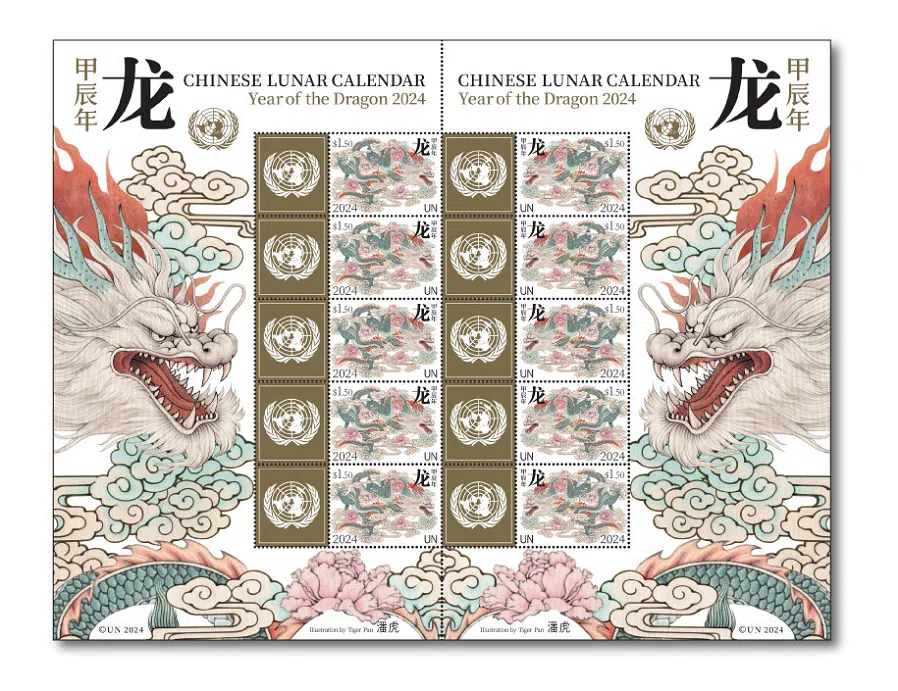Year of the Dragon: How to tell a 'real' dragon from a 'fake' one
Commentator Zhang Tiankan notes that the mythical Chinese dragon has gone through numerous iterations over a long history, and there is not one definitive version of it, much less one "correct" number of claws that it should have. As long as the general image is in line with its majestic and fantastical heritage, the number of claws is secondary.

According to the sexagenary cycle and lunar calendar, 2024 is the Jia Chen Year of the Dragon.
As we usher in the Year of the Dragon, as with the 12 Chinese zodiac signs, a plethora of dragon motifs, portraits and images have sprung up in celebration of the new year. But there have also been controversies involving the image of the dragon, with the most debatable one being whether a dragon is real or fake based on the number of claws on its foot.
China Post has issued commemorative stamps to celebrate the Year of the Dragon, while the United Nations (UN) has also introduced a stamp sheet consisting of ten stamps, each with exquisite dragon illustrations. Wherever there are Chinese people and Chinese traditions, motifs and decorations bearing the image of the dragon will be present. For example, Singapore's Chinatown has been decked out in lights featuring dazzling dragons.
If one looks closer, one would see most of these dragon illustrations have claws, with the majority of them having five claws and others having either three or four claws. But no one would have expected some really observant people to have a problem with the dragon's claws.
Will the 'real' dragon pls stand up?
Apple released a special edition Year of the Dragon AirPods Pro 2, and even released brand new Year of the Dragon iPhone cases on its official website, which features a bright red four-clawed dragon. Illustrated by acclaimed artist Yulong Lli, the auspicious iPhone case exemplifies the dragon's bold personality through bursts of peony-shaped fireworks, swirling lines and bright colours.
... it is clearly oversensitive to elevate particular cases to the level of cultural disrespect just because they are not quite aligned with mainstream culture.

However, the dragon illustration on the iPhone case drew the ire of Chinese netizens, who called for Chinese culture to be respected. For example, netizens pointed out that "in Chinese traditional culture, dragons have five claws while pythons have four", "the image is actually of a python and not a dragon; pythons and dragons are not the same thing", and "since it is a limited edition Dragon Year case, there is a need to have a deeper understanding of Chinese culture".
Not wrong to have four claws
But not everyone agreed with the wave of criticism. Opposing viewpoints asserted that dragons in traditional Chinese culture did not have five claws from the beginning but had evolved from three, four, then five.
Judging whether a dragon is "real" or "fake" by its number of claws stems from culture as well as the formation and changes in the social structure of Chinese society; it is clearly oversensitive to elevate particular cases to the level of cultural disrespect just because they are not quite aligned with mainstream culture.
Dragons do not exist in real life; they were created by ancient Chinese religious totems and cultures, and gradually improved and perfected into the modern image of the dragon that we see today. Thus, from a cultural perspective alone, it is necessary to accept the diverse Chinese dragon illustrations and their various elements, as well as understand the historical changes in the image of the dragon.
This is also how the dragon became known as a composite creature, made up of the parts of nine animals, which was recognised by later generations and reflected in the various illustrations, images, architecture and attires involving the dragon.

Eryayi (《尔雅翼》, a lexicon from the Southern Song period) recorded, "The dragon has the horns of a deer, the head of a camel, the eyes of a rabbit, the neck of a snake, the belly of a cockle, the scales of a carp, the claws of an eagle, the palms of a tiger and the ears of an ox." This is also how the dragon became known as a composite creature, made up of the parts of nine animals, which was recognised by later generations and reflected in the various illustrations, images, architecture and attires involving the dragon.
Since dragons have the claws of an eagle, they should have four claws; three facing forward and one facing backward. Thus, the four-clawed dragon illustration on the iPhone case is not a mistake, as it conforms to historical and cultural prescriptions and even honours the more ancient depiction of a dragon in earlier cultures. It is just that history is constantly evolving and the dragon's image is always evolving and developing as well.
Three- and four-clawed Jinlongs existed between the Tang and Qing dynasties, while five-clawed Jinlongs existed between the Ming and Qing dynasties.
Many dragon types, many looks
And it is not just the dragon's claws that are diverse; the dragon has nine sons and each of them is unique and different. In folklore, there are even four kinds of dragons - Jiaolong (蛟龙, scaled dragon), Yinglong (应龙, winged dragon), Qiulong (虬龙, curling dragon) and Chilong (螭龙, hornless dragon).
However, there are only three types of dragons that correspond to its paws and claws - Kuilong (夔龙), Yinglong and Jinlong (金龙). Correspondingly, the Kuilong is single-clawed and existed between the Shang dynasty and the Warring States period; the Yinglong is three-clawed and existed between the Warring States period and the Sui dynasty; while the Jinlong can be three-, four- or five-clawed. Three- and four-clawed Jinlongs existed between the Tang and Qing dynasties, while five-clawed Jinlongs existed between the Ming and Qing dynasties.

We can see that five-clawed dragons only appeared much later in Chinese history and went on to become the main image and form of the dragon in Chinese culture. Then came the establishment of the supremacy of the dragon - the True Dragon and Son of Heaven (真龙天子) - the most authoritative title of an emperor. Thus, China's first regular stamps were issued by the Qing dynasty in 1897, and bore the dragon motif. The dragon on the stamp had five claws, showing that it was indeed the True Dragon and Son of Heaven.
Time passed, and on 19 January, the UN Postal Administration issued a special stamp sheet in New York to celebrate the upcoming Year of the Dragon. The stamp sheet consists of ten US$1.50-denominated stamps and retails at US$17.95. All stamps feature a dragon illustration, and all dragons have five claws.
The stamps are illustrated by Chinese designer Tiger Pan and feature dragons in the Chinese realist technique. This shows that the Chinese designer of the UN stamp sheet agrees that dragons have five claws. However, the designer of the Apple phone case is also a Chinese who is steeped in Chinese culture. Yet, he drew a four-clawed dragon, showing that the designer identifies more with four-clawed dragons.
In terms of the overall image, a dragon's claws are but a part of the dragon - as long as the overall image of the composite creature largely matches the dragon's image in traditional Chinese culture, they can be considered loyal to Chinese culture.

The lighted dragon in Singapore's Chinatown is also four-clawed; three facing forward and one facing backward. The dragon was designed by 13 students from the Singapore University of Technology and Design over roughly nine months. I am certain that they took into account traditional Chinese culture, but took a modern spin and did not cling to the idea of a five-clawed dragon.
Loyal to Chinese culture?
In terms of the overall image, a dragon's claws are but a part of the dragon - as long as the overall image of the composite creature largely matches the dragon's image in traditional Chinese culture, they can be considered loyal to Chinese culture. The dragons on the iPhone case and the UN's stamp sheet are both vivid and appear like dragons flying in the clouds, embodying the mysterious and majestic nature of the legendary creature.
Dragons are just a mythical creature - there is no need to be too caught up with specific details. Whether they are three-, four- or five-clawed, or without claws altogether, it does not matter. As long as its overall image conforms to the depiction in Chinese culture - that is, the dragon is a composite creature consisting of the parts of nine animals - we should just look at the big picture and leave the minute details alone.
This article was first published in Lianhe Zaobao as "真龙不在爪".

![[Big read] Paying for pleasure: Chinese women indulge in handsome male hosts](https://cassette.sphdigital.com.sg/image/thinkchina/c2cf352c4d2ed7e9531e3525a2bd965a52dc4e85ccc026bc16515baab02389ab)



![[Big read] How UOB’s Wee Ee Cheong masters the long game](https://cassette.sphdigital.com.sg/image/thinkchina/1da0b19a41e4358790304b9f3e83f9596de84096a490ca05b36f58134ae9e8f1)